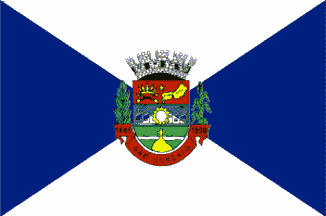 image by André Pires Godinho
image by André Pires Godinho
Last modified: 2012-04-07 by ian macdonald
Keywords: rio de janeiro | são gonçalo | coat of arms | saltire |
Links: FOTW homepage |
search |
disclaimer and copyright |
write us |
mirrors
Area: 250.7 Sq.Km
Population: 889,828
Region: Metropolitan Area
André Pires Godinho, 20 February 2003
The municipality of São Gonçalo (1,008,064 inhabitants in 2010, therefore the 2nd most populous municipality in the State and the 16th in Brazil; 249 sq. km) is located in the Rio de Janeiro Metropolitan Area, 25 km of Rio de Janeiro. The municipality is made of the town of São Gonçalo proper and of the districts of Ipiíba, Monjolos, Neves and Sete Pontes.
São Gonçalo was founded on 6 April 1579 by Gonçalo Gonçalves. The settlement developed around the Colubandê estate, founded by the Jesuits in the early 17th century. Remains of the early colonization of the area are the Nossa Senhora da Boa Esperança estate (Ipiíba), Captain Miguel Frias de Vasconcelos' estate, the Small Mill, the St. John chapel, the Gradim port and the Luz estate (Itaóca). The municipality of São Gonçalo was established by State Decree No. 124 of 22 September 1890, seceding from Niterói. Reincorporated as a district to Niterói by Decree No. 1 of 8 May 1862, the municipality was quickly reestablished by Decree No. 34 of 7 December 1890. The district of Itaipú was transferred in 1943 from São Gonçalo to Niterói. In the 1930-1950s, São Gonçalo was the main industrial center in the State, being nicknamed the "Rio de Janeiro Manchester". The "Cerâmica do Rosa" factory, founded on 20 January 1941, is the oldest and main ceramic factory in the town. The "Companhia Brasileira de Usinas Metalúrgicas" (CBUM) factory is among the biggest iron and steel producers in South America. The "Companhia Eletroquímica Fluminense" factory, founded on 20 June 1933 and today closed, was the sole producer of chloride, hydrogen and soda by electrolysis in the country. The "Companhia Nacional de Cimento Portland de Lone Star Cement", founded in 1933, produced 800 tons of Portland cement per day; to transport its products, the company built a private railway ("Estrada de Ferro Industrial") and a canal linked to river Guaxindiba ("Canal Guaxindiba") Most of the production was transferred to Cahtagalo, located closer to the limestone sources, only mortar being still produced in São Gonçalo. The "Indústrias Reunidas Mauá" glassworks, founded in Neves on 5 October 1941, is the sole producer of neutral glass in South America. The "Indústrias de Conserva Coqueiro" canning factory, founded in Porto Velho in 1937, originally shipped canned sardines all over Brazil; sold in 1990 to "Indústria Quaker Produtos Alimentícios", the company still sells its products under its original brand name. The "Lloyd Brasileiro", once the biggest shipping company in South America, was founded on 22 November 1888 by Artur Silveira da Mota, Baron of Jacegua, with Imperial permission subsequently confirmed by the Republican government.
The symbols of São Gonçalo are prescribed by Deliberation No. 557 of
10 September 1969.
The coat of arms is made of a Portuguese shield, tierced per fess, 1.
Gules two arrows per saltire ensigned with a feather crown, a star, a
map of the Rio de Janeiro state all or, 2. Azure a cog wheel or over
seven factories with two chimneys on the border all argent, 3. Vert a
fess wavy argent in base a mound ensigned with a cross all or. The
shield surmounted by a five-towered mural crown argent, representing a
"cidade". The shield surrounded dexter by a branch of coffee fructed
proper and sinister by a plant of maize proper. Below the shield a
scroll gules inscribed with the name of the municipality and the years
"1646" dexter and "1890" sinister all argent.
The coat of arms highlights the industrial, agriculture and religious
characteristics of the municipality.
http://www.saogoncalo.rj.gov.br/simbolos_civicos.php
Ivan Sache, 18 March 2012